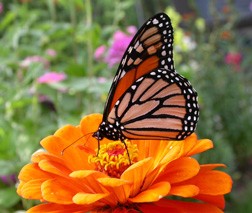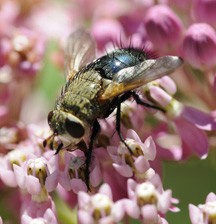Monarch Butterflies and Some Natural Enemies
- Share
- Tweet
- Pin
- Share

How many Monarch Butterflies have you been seeing this summer?
Thinking back to this past May, our region was experiencing considerably earlier-than-normal spring weather. Much to our joy we watched a female Monarch Butterfly on Mothers’ Day, May 13, deposit seven of her extremely tiny pearl-like eggs on the small, emerging green shoots of a Swamp Milkweed growing in our front yard. This was by far the earliest sighting of one of these amazing butterflies I’ve ever recorded since I came to Door County in June of 1964.
As soon as the eggs hatched I watched the caterpillars on a daily basis slowly devour some of the leaves of the Swamp Milkweed and also those of a few of the Tropical Milkweeds, Asclepias curassavica, also growing in our butterfly wayfaring garden. This 4-foot by 8-foot raised flower bed has been planted with the tall orange-flowered Tithonias, lavender Verbenas, Swamp or Red Milkweeds, Tropical Milkweeds, Purple Coneflowers, and some Mexican Cigar Plants, Cuphea ignea (COO-fee-a IG-nee-a), highly attractive to hummingbirds.
Even though the butterfly wayfaring garden’s main purpose is to offer host milkweed plants for the Monarch caterpillars in early-to-mid summer and much needed nectar for the migrating Monarchs in late summer and early fall, the plants also are constantly attracting and helping to feed other wild creatures. This small isolated garden and the two, 20-foot beds of zinnias along our front sidewalk have proven to be virtual Meccas for butterflies, hummingbirds and also several Hummingbird and Snowberry Clearwing Moths.
Nearly always in past years in June, July and into early August I’ve been able to locate at least a half dozen Monarch chrysalids attached to various places around our front patio, for example to the underside surfaces of the Leopold bench, a large carved wooden mushroom next to our front door and especially to the under-edges of the aluminum siding of our house. Sadly, this summer, up to August 14, I’ve not discovered a single chrysalid, and this too is something that has never occurred at our place.

The caterpillar of the Monarch Butterfly.
As mentioned earlier, our Monarch season started off in great style on May 13. Then on May 15 Charlotte and I helped to preview a hike for the Door County Land Trust’s preserve in the Shivering Sands area. We were overjoyed with the dozens of Monarch Butterflies seen that morning. Gradually as summer progressed, we observed fewer and fewer Monarchs, much to our great disappointment.
We were informed by Carl and Ruth Scholz of a friend living east of Sturgeon Bay of their having had good success raising in captivity several dozen Monarch larvae to the adult stage and then releasing them. I have nothing but high praise for educational and heart-warming ventures such as this.
Overall, however, I feel that this has been truly a disastrous summer here for these large orange and black winged creatures. According to reports coming from the Monarch experts, Dr. Lincoln Brower among others, these butterflies have been experiencing increasingly bad years. Their wintering sites in the mountains of central Mexico being dangerously encroached upon by illegal logging operations and harmfully altered to the point that severe winters have killed many millions of monarch, along with severe droughts in their summering sites in the U.S. and Canada, have all led to the decline of this species.
Monarch Butterflies also have many natural enemies as do other small creatures. They include, for example, Praying Mantids, Spined Soldier Bugs, Jumping and Orb-weaving Spiders, Braconid Flies and at least four species of Tachinid Flies. It was on this past July 21 that I took interest in a growing number of unusual flies, slightly larger than house flies, nectaring on the Tithonia flowers in our butterfly garden. For all I know a small number of them may have been at the flowers throughout June and July and simply escaped my attention.

Slightly larger than the House Fly, the Tachinid Fly is a bizarre-looking insect.
I had been photographing butterflies and couldn’t help notice the unusual flies with very hairy or spiny black abdomens. With digital photography being so convenient to the point that you can take a picture one minute and have the image enlarged on your computer screen the next is quite amazing. Here was an insect that I had never photographed in the past and which, fortunately, was fairly easy to identify using some of my insect field guides.
Indeed they turned out to be Tachinid (TAK-i-nid) Flies whose nourishment comes from the nectar of flowers. The species in our yard had dark, very hairy and spiny abdomens, large rusty-red compound eyes and moved fairly slowly. Actually a close look also revealed black spiny hairs on other parts of the insect’s body, a very strangely-shaped head and face, and what appeared to be a most bizarre, difficult-to-imagine creature. I’m glad they were only slightly larger than an ordinary House Fly.
It didn’t require much studying to learn that these flies belong to the second largest family of flies in North America, there being over 1,300 species. Many Tachinids are important natural enemies of major insect pests. In general these flies attach their tiny eggs usually on the larvae of their host insects, virtually “gluing” the eggs to the outer body surfaces. The eggs hatch and the tiny maggots eat their way into the caterpillars and usually eventually kill them by gradually consuming their bodies.

Eggs of this Tachinid Fly laid on a Monarch Butterfly caterpillar will very likely kill the caterpillar.
Occasionally the Tachinid eggs are laid on the Monarch caterpillars in the late stages of their development. These larvae will form their chrysalids satisfactorily but unfortunately they will not properly complete the cycle to the adult butterfly stage.
Yes, among a host of various diseases, parasites and viruses, Tachinid Flies are also considered to be one of the fairly common natural enemies of the caterpillars of the Monarch Butterflies. The belief is that these natural enemies of the Monarchs actually take a relatively small number of the larvae each year and are nothing to be too concerned about.
Nevertheless I can’t help but deduce that the fairly large concentration of Tachinid Flies in our front yard this summer may have led to the very poor showing at our place of the Monarchs. Let’s hope that next spring and summer will bring better weather, more rain, lower temperatures along with a total lack of Tachinid Flies, and a much better showing of one of the Midwest’s favorite insects, the Monarch Butterfly.

